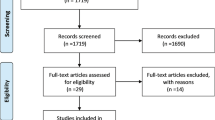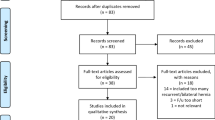Abstract
Background
Reinforcement of inguinal hernia repair with prosthetic mesh is standard practice but can cause considerable pain and stiffness around the groin and affect physical functioning. This has led to various types of mesh being engineered, with a growing interest in lighter-weight mesh. Minimally invasive approaches have also significantly reduced postoperative recovery from inguinal hernia repair. The aim of this systematic review was to compare the outcomes after laparoscopic inguinal repair using new lightweight or traditional heavyweight mesh in published randomised controlled trials.
Methods
Medline, Embase, trial registries, conference proceedings, and reference lists were searched for controlled trials of heavyweight versus lightweight mesh for laparoscopic repair of inguinal hernias. The primary outcomes were recurrence and chronic pain. Secondary outcomes were visual analogue pain score at 7 days postoperatively, seroma formation, and time to return to work. Risk differences were calculated for categorical outcomes and standardised mean differences for continuous outcomes.
Results
Eight trials were included in the analysis of 1,667 hernias in 1,592 patients. Mean study follow-up was between 2 and 60 months. There was no effect on recurrence [pooled analysis risk difference 0.00 (95% CI −0.01 to 0.01), p = 0.86] or chronic pain [pooled analysis risk difference −0.02 (95% CI −0.04 to 0.00); p = 0.1]. Lightweight and heavyweight mesh repair had similar outcomes with regard to postoperative pain, seroma development, and time to return to work.
Conclusion
Both mesh options appear to result in similar long- and short-term postoperative outcomes. Further long-term analysis may guide surgeon selection of mesh weight for laparoscopic inguinal hernia repair.










Similar content being viewed by others
References
Lichtenstein IL, Shulman AG (1986) Ambulatory outpatient hernia surgery. Including a new concept, introducing tension-free repair. Int Surg 71:1–4
Bringman S, Wollert S, Osterberg J, Smedberg S, Granlund H, Heikkinen TJ (2006) Three-year results of a randomized clinical trial of lightweight or standard polypropylene mesh in Lichtenstein repair of primary inguinal hernia. Br J Surg 93:1056–1059
Hakeem A, Shanmugam V (2011) Inguinodynia following Lichtenstein tension-free hernia repair: a review. World J Gastroenterol 17:1791–1796
Karthikesalingam A, Markar SR, Holt PJ, Praseedom RK (2010) Meta-analysis of randomized controlled trials comparing laparoscopic with open mesh repair of recurrent inguinal hernia. Br J Surg 97:4–11
Memon MA, Cooper NJ, Memon B, Memon MI, Abrams KR (2003) Meta-analysis of randomized clinical trials comparing open and laparoscopic inguinal hernia repair. Br J Surg 90:1479–1492
Aasvang EK, Gmaehle E, Hansen JB, Gmaehle B, Forman JL, Schwarz J, Bittner R, Kehlet H (2010) Predictive risk factors for persistent post-herniotomy pain. Anesthesiology 112:957–969
Harrell AG, Novitsky YW, Cristiano JA, Gersin KS, Norton HJ, Kercher KW, Heniford BT (2007) Prospective histologic evaluation of intra-abdominal prosthetics 4 months after implantation in a rabbit model. Surg Endosc 21:1170–1174
Hollinsky C, Sandberg S, Koch T, Seidler S (2008) Biomechanical properties of lightweight versus heavyweight meshes for laparoscopic inguinal hernia repair and their impact on recurrence rates. Surg Endosc 22:2679–2685
Akolekar D, Kumar S, Khan LR, de Beaux AC, Nixon SJ (2008) Comparison of recurrence with lightweight composite polypropylene mesh and heavyweight mesh in laparoscopic totally extraperitoneal inguinal hernia repair: an audit of 1,232 repairs. Hernia 12:39–43
O’Dwyer PJ, Kingsnorth AN, Molloy RG, Small PK, Lammers B, Horeyseck G (2005) Randomized clinical trial assessing impact of a lightweight or heavyweight mesh on chronic pain after inguinal hernia repair. Br J Surg 92:166–170
McCormack K, Wake BL, Fraser C, Vale L, Perez J, Grant A (2005) Transabdominal pre-peritoneal (TAPP) versus totally extraperitoneal (TEP) laparoscopic techniques for inguinal hernia repair: a systematic review. Hernia 9:109–114
Wake BL, McCormack K, Fraser C, Vale L, Perez J, Grant AM (2005) Transabdominal pre-peritoneal (TAPP) vs. totally extraperitoneal (TEP) laparoscopic techniques for inguinal hernia repair. Cochrane Database Syst Rev 1:CD004703
Jadad AR, Moore RA, Carroll D, Jenkinson C, Reynolds DJ, Gavaghan DJ, McQuay HJ (1996) Assessing the quality of reports of randomized clinical trials: is blinding necessary? Control Clin Trials 17:1–12
DerSimonian R, Laird N (1986) Meta-analysis in clinical trials. Control Clin Trials 7:177–188
Higgins JP, Thompson SG (2002) Quantifying heterogeneity in a meta-analysis. Stat Med 21:1539–1558
Agarwal BB, Agarwal KA, Mahajan KC (2009) Prospective double-blind randomized controlled study comparing heavy- and lightweight polypropylene mesh in totally extraperitoneal repair of inguinal hernia: early results. Surg Endosc 23:242–247
Bittner R, Leibl BJ, Kraft B, Schwarz J (2011) One-year results of a prospective, randomised clinical trial comparing four meshes in laparoscopic inguinal hernia repair (TAPP). Hernia 15:503–510
Chowbey PK, Garg N, Sharma A, Khullar R, Soni V, Baijal M, Mittal T (2010) Prospective randomized clinical trial comparing lightweight mesh and heavyweight polypropylene mesh in endoscopic totally extraperitoneal groin hernia repair. Surg Endosc 24:3073–3079
Chui LB, Ng WT, Sze YS, Yuen KS, Wong YT, Kong CK (2010) Prospective, randomized, controlled trial comparing lightweight versus heavyweight mesh in chronic pain incidence after TEP repair of bilateral inguinal hernia. Surg Endosc 24:2735–2738
Peeters E, Spiessens C, Oyen R, De Wever L, Vanderschueren D, Penninckx F, Miserez M (2010) Laparoscopic inguinal hernia repair in men with lightweight meshes may significantly impair sperm motility: a randomized controlled trial. Ann Surg 252:240–246
Langenbach MR, Schmidt J, Ubrig B, Zirngibl H (2008) Sixty-month follow-up after endoscopic inguinal hernia repair with three types of mesh: a prospective randomized trial. Surg Endosc 22:1790–1797
Bringman S, Wollert S, Osterberg J, Heikkinen T (2005) Early results of a randomized multicenter trial comparing prolene and vypro II mesh in bilateral endoscopic extraperitoneal hernioplasty (TEP). Surg Endosc 19:536–540
Heikkinen T, Wollert S, Osterberg J, Smedberg S, Bringman S (2006) Early results of a randomised trial comparing prolene and vypro II-mesh in endoscopic extraperitoneal inguinal hernia repair (TEP) of recurrent unilateral hernias. Hernia 10:34–40
Khan LR, Liong S, de Beaux AC, Kumar S, Nixon SJ (2010) Lightweight mesh improves functional outcome in laparoscopic totally extra-peritoneal inguinal hernia repair. Hernia 14:39–45
Yunis J (2009) Critical issues in groin hernia management. Surg Technol Int 18:119–124
Lauscher JC, Yafaei K, Buhr HJ, Ritz JP (2008) Total extraperitoneal hernioplasty: does the long-term clinical course depend on the type of mesh? J Laparoendosc Adv Surg Tech A 18:803–808
Lo Menzo E, Spector SA, Iglesias A, Martinez JM, Huaco J, DeGennaro V, Madan AK (2009) Management of recurrent inguinal hernias after total extraperitoneal (TEP) herniorrhaphies. J Laparoendosc Adv Surg Tech A 19:475–478
Phillips EH, Rosenthal R, Fallas M, Carroll B, Arregui M, Corbitt J, Fitzgibbons R, Seid A, Schultz L, Toy F et al (1995) Reasons for early recurrence following laparoscopic hernioplasty. Surg Endosc 9:140–144. Discussion 144–145
Schrenk P, Woisetschlager R, Rieger R, Wayand W (1996) Prospective randomized trial comparing postoperative pain and return to physical activity after transabdominal preperitoneal, total preperitoneal or shouldice technique for inguinal hernia repair. Br J Surg 83:1563–1566
Gong K, Zhang N, Lu Y, Zhu B, Zhang Z, Du D, Zhao X, Jiang H (2011) Comparison of the open tension-free mesh-plug, transabdominal preperitoneal (TAPP), and totally extraperitoneal (TEP) laparoscopic techniques for primary unilateral inguinal hernia repair: a prospective randomized controlled trial. Surg Endosc 25:234–239
Acknowledgments
The authors thanked Drs. Pradeep Chowbey, Brij Agarwal, Marc Miserez, and Timo Heikkinen for providing further data for inclusion in this meta-analysis.
Disclosures
Drs. Currie, Andrew, Tonsi, Hurley, and Taribagil have no conflicts of interest or financial ties to disclose.
Author information
Authors and Affiliations
Corresponding author
Rights and permissions
About this article
Cite this article
Currie, A., Andrew, H., Tonsi, A. et al. Lightweight versus heavyweight mesh in laparoscopic inguinal hernia repair: a meta-analysis. Surg Endosc 26, 2126–2133 (2012). https://doi.org/10.1007/s00464-012-2179-6
Received:
Accepted:
Published:
Issue Date:
DOI: https://doi.org/10.1007/s00464-012-2179-6




